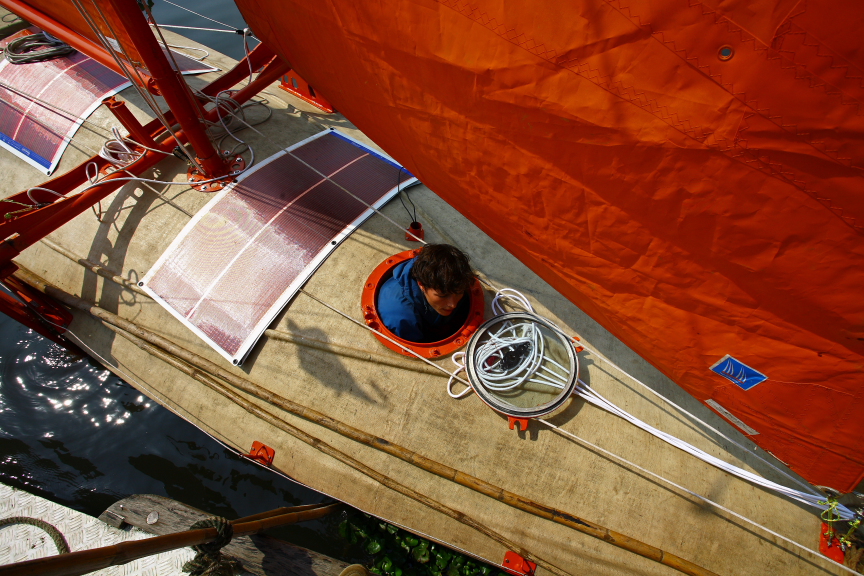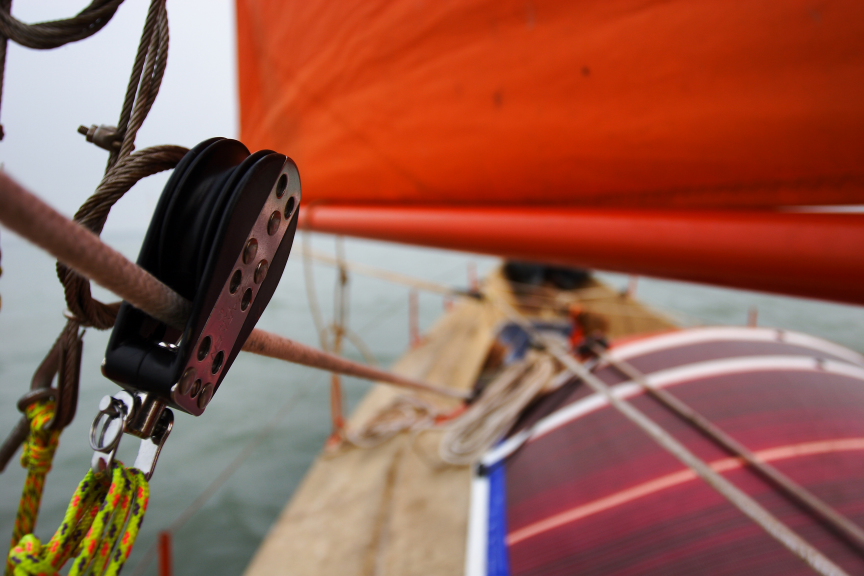By | Bogdana
Corentin Dechatel Chatelperron locally named Coco, a young French engineer who sailed off from Dhaka preparing to link Bangladesh to France by sea on traditionally designed small fishing boat made out of jute composite – for the first time ever in the world. The purpose of this crossing is to attract the attention of the international community an innovative and ambitious economic development and solidarity for Bangladesh.
Sailing off from Kuakata | © Muntasir Mamun Imran / Kewkradong.com
He has prepared his trip for more than 6 months. His project began last summer of 2009. “Two friends came to visit me on holidays. We left for a few days exploring the banks of the Brahmaputra and that’s where the idea was born” he replied. Their cruise was conducted aboard on a prototype fishing boat of Bangladesh on which Corentin had worked during his eight months of volunteering in the shipyard by the river Bangshi of Savar. This has inspired to design the first yacht in the world designed to 40% of jute and 60% glass fiber. He hopes that this innovation will attract investors, promising to create an applied research center in Dhaka.
Why the burlap for the boat? He replied – “I knew that natural fibers like flax or hemp were much studied in France. In Bangladesh, research has been done on burlap, but this time there was no direct application in the naval sector “. So that’s why! One material is commonly used in naval manufacture, fiberglass. Energy used in design, wastes are difficult to recycle and expensively imported most of the time. Country like Bangladesh with the largest fleet in the world, the use of this material may be approached as a disaster both ecologically and economically.
For Corentin, the time is ideal for suggests an alternative to fiberglass. The burlap is a tremendous opportunity for innovation. It also presents the advantage of being produced locally by the existence of secular manufacturing plants, symbols of prosperity for centuries. Corentin the project would boost the economy of Bangladesh in decline.
Ambitious and innovative, this adventure is not a whim. Long matured, Corentin has the means to succeed with his ardency of helping the heritage and culture of Bangladeshis.
With the help of laboratory test, he was able to perform resistance testing prior to this natural fiber. Moreover, he gained the support of the prestigious firm of French naval architecture VPLP for many years Friendship partner. Mark Van Pethegem, one of the directors of Tara Tari Shipyard, seduced by the originality of the project, and Gwenolé Gahinet, an engineer with VPLP have designed the hull and deck. They drew the boat on the lines of traditional fishing boats of Kuakata of Bangladesh vow to Corentin.

On his Shipyard Tara Tari | © Muntasir Mamun Imran/kewkradong.com
“This crossing is the first life test of the potential use of fishing boats designed entirely from burlap from Bay of Bengal to the Medeterian Sea. It was unthinkable for me to go with another boat. But indeed the local knowledge of naval architectural of Bangladesh which has been tasted by the time made my task easier with the help of VPLP. For six months at sea on a fishing boat in experimental composite is a bold initiative, just a challenge to Corentin with a profoundness of would class adventure on its esteem.
Just sailing was neither a performance nor in tune with my project. In the long term, certainly I would like to return to Bangladesh and work in the design of boats 100% Green-with the integration of Bio-résine can soon build ships 100% biodegradable! Cheap and efficient. A sustainable development project that is ambitious for this crossing a scientific expedition just as a sporting challenge.

His boat | © Muntasir Mamun Imran/kewkradong.com
Performed solo since the Bay of Bengal until Mediterranean he personally financed his voyage hoping that after the trip he will raise funds for the research center here in Bangladesh.
“I still have the autopilot to some connections and install the electrical panel to validate but the key is there. And then I have nothing to fear: the boat is unsinkable! I might even go now … . No technical risk, therefore, remains that of adventure.
Wednesday, February 16, 6h. Corentin waiting patiently for the tide takes Tara Tari seaward. The sea is calm. The wind blows a good omen. In the humid air of dawn, fishermen chanted traditional songs sailors.




Aucun commentaire:
Enregistrer un commentaire